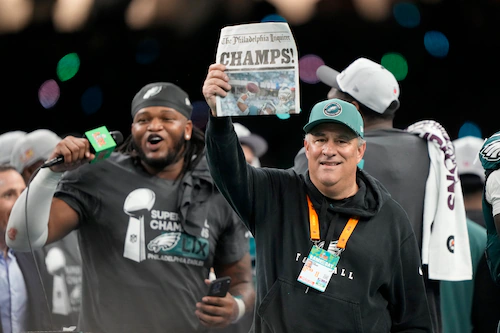DETROIT — Now that the football season is over, let’s take a closer look at what the Detroit Lions can learn from the Super Bowl champion Philadelphia Eagles.
These two teams are built very similarly, with a focus on building through the trenches and a stellar draft-and-develop reputation. More often than not, the Lions and Eagles are at the top of the discussion when it comes to who has the best offensive line in the NFL.
They also went out and added superstar Saquon Barkley when the Giants let him walk and just got the most productive year in league history — season and postseason combined — from the running back. The Lions are set at running back, but it highlights the risk and aggressive approach to veteran talent acquisition from the newly-minted Super Bowl champions.
For example, the Lions have six players with contracts of more than $50 million and five earning an annual salary of at least $20 million. So, they are on their way to checking that box with more extensions on the horizon. Still, the Eagles have spent that money on more than internal retentions — hint, like a potential move to add someone of Myles Garrett’s caliber.
The Eagles traded for cornerback Darius Slay at the start of this four-year journey with two Super Bowl appearances and now one championship. They also spent the money to extend and keep Slay around. They also traded for star receiver A.J. Brown, then paid to keep him around. They even found more money to get former Lions safety C.J. Gardner-Johnson to come back after trashing their fans and talking smack on his way out the door the first time.
That’s a perfect segue into the risk-taking differences. The Lions have done everything possible to protect their locker room culture while being responsible for how they spend on the open market. Taking care of their own and those who they have drafted and developed has been a primary focus.
One of the main things the Lions need to consider as they enter a new level of roster-building after two seasons of contention and coming close is how the Eagles have gone all-in on spending every dime possible. The Eagles have eight players with contracts greater than $50 million, with six others earning an average annual salary of at least $20 million.
Both teams also feature an impressive stockpile at wide receiver, a great tight end and a dynamic rushing attack on the offensive side of the ball. The Eagles are boosted by the dual-threat ability of quarterback Jalen Hurts, something the Lions won’t have with Jared Goff, so let’s move along there.
But, much like some of the other likenesses between these two teams, there are enough differences for us to look into and examine how they might work for the Lions, now or in the future.
Heck, one of the heroes of last night’s Super Bowl win was 2021 third-round pick Milton Williams. He’s noticed 11.5 sacks across 67 games played and forced a key strip-sack fumble on quarterback Patrick Mahomes last night.
The Lions hit on third-round picks Alim McNeill and Kerby Joseph in Holmes’ first two drafts at the helm. McNeill is a stud who has already received a big-money extension. Joseph just led the league in interceptions and should see some extra zeroes on the way to his bank account sooner rather than later.
But Manu was not active for a game this past season. Vaki was limited to special teams. Hooker has played three games and was passed in the depth chart by backup quarterback Teddy Bridgewater in the playoffs despite the latter being retired for most of the 2024 campaign. And Martin has played five games and has no sacks and only four tackles to his name in two seasons.
As the roster tightens and there is less of a window to make the roster and contribute, the Lions could follow Philly’s path of trying to find players who can help now and not potentially a couple of years down the road.
The Lions and Eagles are built similarly. Holmes and Campbell have the Lions on the right road ahead, but there are things to learn from the new champions.





























